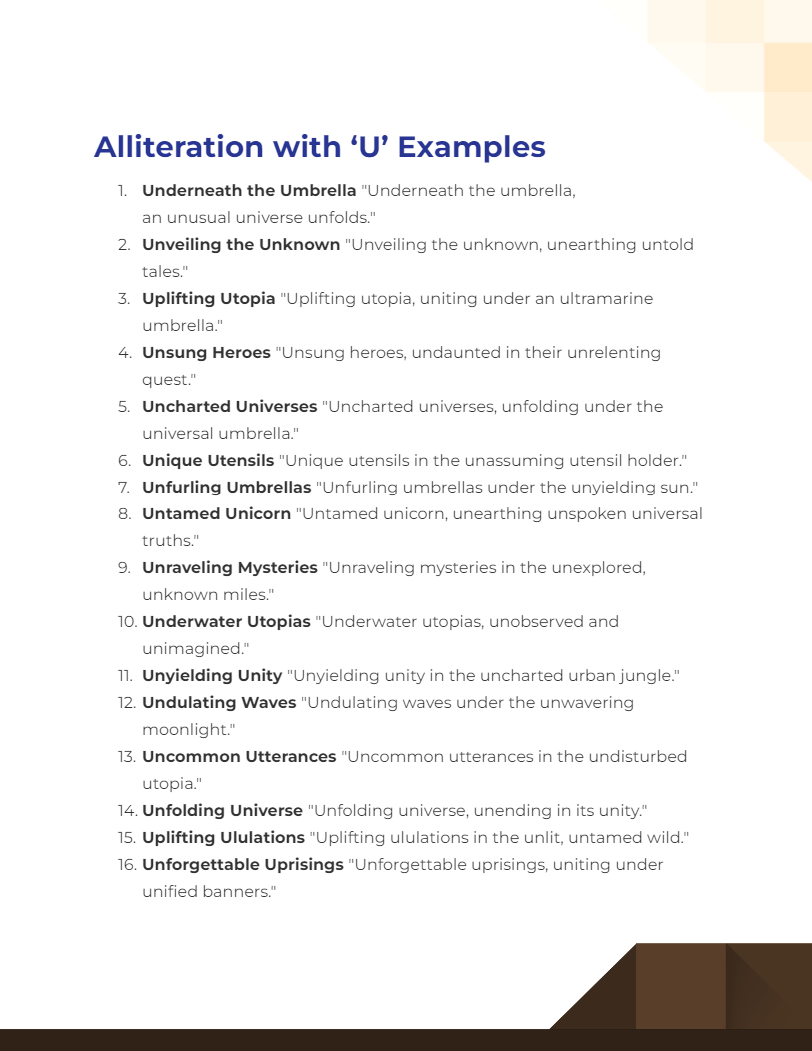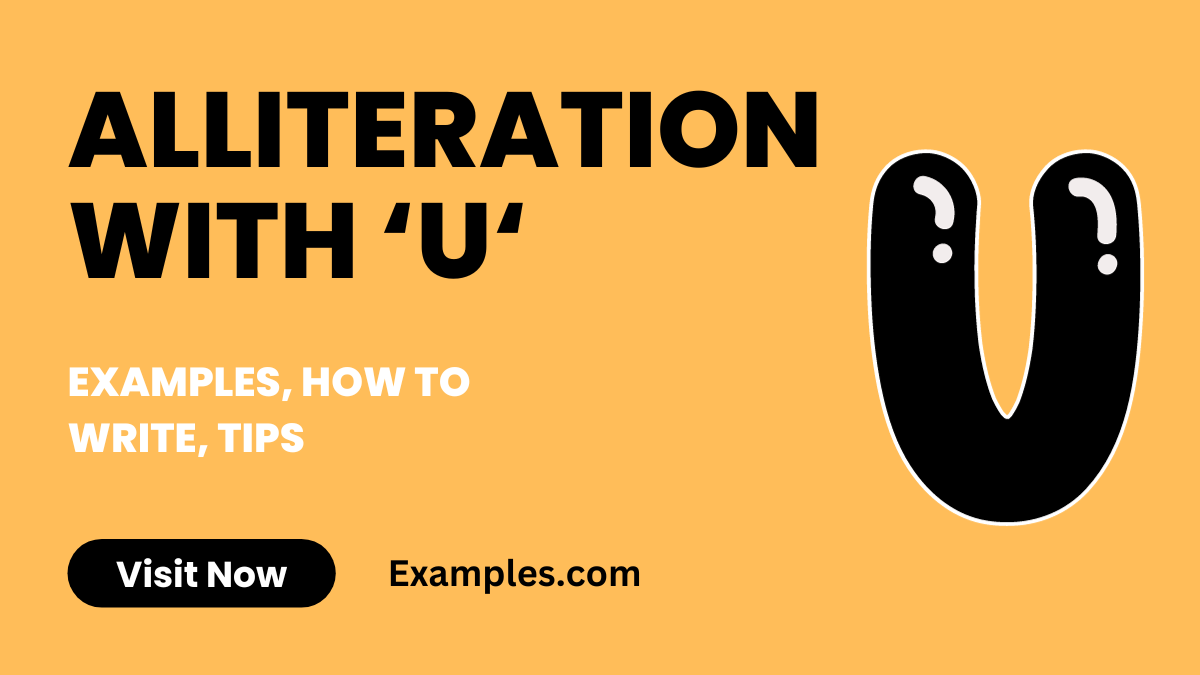Alliteration with U
Alliteration with the letter ‘U’ unveils a unique charm in literary compositions, bringing a soft yet impactful resonance to phrases and sentences. This form of alliteration involves the repetition of the ‘U’ sound at the start of adjacent or closely linked words, creating a smooth and flowing sound effect. It’s particularly effective in setting a gentle, understated mood or emphasizing certain points subtly. When using ‘U’ for alliteration, writers can infuse their prose or poetry with a lyrical quality that gently draws the reader’s attention. Mastering famous alliterations technique can elevate your writing, whether in creative storytelling, poetry, or even persuasive writing, adding an elegant and subtle rhythmic quality.
Download Alliteration with 'U' Examples
Download Alliteration with 'A' to 'Z' Examples
What is the Best Example of Alliteration with ‘U’?

Example: A classic example of alliteration with the letter ‘U’ is the phrase “Under the umbrella, the unicorn danced.”
Meaning: Alliteration is a literary device that involves the repetition of the same initial consonant sound in a series of words within a sentence or phrase. In the example “Under the umbrella, the unicorn danced,” the consonant ‘U’ is repeated at the beginning of several words, creating a pleasing and rhythmic sound pattern. Alliteration is often used in poetry, literature, and tongue twisters to add emphasis, musicality, and a sense of unity to the text. In this specific example, the easy alliteration repeated ‘U’ sound enhances the whimsical and imaginative quality of the sentence, making it both fun and memorable.
20 Alliteration with ‘U’ Examples

Download Alliteration with 'U' Examples in PDF
Alliteration with the letter ‘U’ unveils a universe of uncommon and unique utterances, creating an unusual and often underused auditory experience. The ‘U’ sound, known for its softness and sometimes elusive quality, is perfect for crafting hard alliteration examples. Especially effective in alliteration in rhymes, the ‘U’ sound adds a subtle and engaging dimension to verses. Here are 20 unique examples of alliteration with ‘U’, each complemented by a rhyme title that encapsulates the essence of the phrase.
- Underneath the Umbrella “Underneath the umbrella, an unusual universe unfolds.”
- Unveiling the Unknown “Unveiling the unknown, unearthing untold tales.”
- Uplifting Utopia “Uplifting utopia, uniting under an ultramarine umbrella.”
- Unsung Heroes “Unsung heroes, undaunted in their unrelenting quest.”
- Uncharted Universes “Uncharted universes, unfolding under the universal umbrella.”
- Unique Utensils “Unique utensils in the unassuming utensil holder.”
- Unfurling Umbrellas “Unfurling umbrellas under the unyielding sun.”
- Untamed Unicorn “Untamed unicorn, unearthing unspoken universal truths.”
- Unraveling Mysteries “Unraveling mysteries in the unexplored, unknown miles.”
- Underwater Utopias “Underwater utopias, unobserved and unimagined.”
- Unyielding Unity “Unyielding unity in the uncharted urban jungle.”
- Undulating Waves “Undulating waves under the unwavering moonlight.”
- Uncommon Utterances “Uncommon utterances in the undisturbed utopia.”
- Unfolding Universe “Unfolding universe, unending in its unity.”
- Uplifting Ululations “Uplifting ululations in the unlit, untamed wild.”
- Unforgettable Uprisings “Unforgettable uprisings, uniting under unified banners.”
- Untold Utopian Dreams “Untold utopian dreams, unfolding under stars.”
- Unusual Undertakings “Unusual undertakings in the urban undergrowth.”
- Unwavering Undertones “Unwavering undertones in the unspoken utterances.”
- Unseen Universes “Unseen universes, unfathomable in their unlikeness.”
Alliteration Sentence Examples with ‘U’
Alliteration sentence examples with ‘U’ often create a unique and unified tone, using the ‘U’ sound to establish a subtle but distinct rhythm. This type of alliteration is common in various literary forms, including alliteration in poems, songs, and movies, where it adds an understated elegance to the narrative. Here are three examples:
- “Ursula’s umbrella unfurled under the ultraviolet rays unexpectedly.”
- “Upon the uppermost branch, the umber owl uttered an unusual cry.”
- “Unity and understanding underpin Ulysses’ ultimate undertaking.”
Alliteration Examples with ‘U’ Words
Alliteration examples using ‘U’ words demonstrate how this vowel can create an enigmatic and intriguing effect in language. Often used in alliteration in songs, the ‘U’ sound can add depth and resonance. Here are three examples:
- “Unseen undercurrents undercut the undisturbed surface.”
- “Urgent undertakings upended the usual undertones of tranquility.”
- “The university’s unorthodox approach unveiled unexpected insights.”
Alliteration Poems with ‘U’
An alliteration poem with ‘U’ employs the repetitive ‘U’ sound to create a rhythmically and aesthetically engaging poetic experience. Alliteration in poems, especially with the ‘U’ sound, brings forth a unique lyrical quality. Here are three examples:
- “Under the universe’s vast umbrella, / Unseen stars unveil their drama.”
- “Urgent whispers under the moon, / Unraveling secrets, unspoken soon.”
- “Upon the uplands, under sky so blue, / Unfolding scenes of nature’s hue.”
Alliteration Starting with ‘U’
Alliteration beginning with ‘U’ sets a particular tone and rhythm in a phrase, often creating a mysterious and impactful auditory experience. Found in various artistic expressions, including alliteration in movies, it adds a distinctive flair. Here are three examples:
- “Underneath the urban sky, unknown tales unfold.”
- “Uplifting melodies ushered in an era of unity.”
- “Unwaveringly, Ursula undertook the uphill journey.”
How to Write Alliteration with ‘U’?
Writing alliteration with the letter ‘U’ involves strategically placing words that start with the ‘U’ sound close together in phrases or sentences. The ‘U’ sound, known for its softness and subtlety, can add a unique and sometimes understated rhythm to your writing. This technique is versatile and can be used in various contexts, from educational content for first graders to more sophisticated alliteration in figurative language. Here’s a step-by-step guide to creating effective alliteration with ‘U’:
- Understand the ‘U’ Sound: Familiarize yourself with the ‘U’ sound. It can be pronounced as in “umbrella” or as in “use.” Each variation offers a different auditory experience.
- Select a Theme or Concept: Choose a theme or subject that can be effectively described with ‘U’ words. This will help you find relevant words that fit your topic, whether you’re crafting alliteration with answers or for creative expression.
- Brainstorm ‘U’ Words: Compile a list of words starting with ‘U’. Include a mix of nouns, verbs, and adjectives to add variety to your alliteration.
- Formulate Your Phrase or Sentence: Construct a sentence or phrase using your chosen ‘U’ words. Aim for a natural flow that highlights the alliterative effect.
- Read Aloud for Rhythm: Alliteration’s effectiveness is often best judged audibly. Read your sentence aloud to ensure it flows well and the ‘U’ sound is pronounced clearly.
- Revise for Clarity and Impact: Ensure your alliterative phrase is clear and contributes effectively to your overall message or story.
- Apply in Various Contexts: Whether it’s in alliteration figurative language exercises, as part of teaching alliteration for first grade, or in creative writing, adapt your use of ‘U’ alliteration to suit the purpose and audience.
Tips for Using Alliteration with ‘U’
Here are the Tips for Using Alliteration with ‘U’:
- Use Sparingly: Given the less common nature of ‘U’ words, use this alliteration judiciously to avoid forcing your text or making it feel unnatural.
- Maintain Clarity: Your primary goal is to convey a message clearly. Alliteration should not overshadow your narrative but complement it.
- Embrace the Uniqueness: The ‘U’ sound naturally lends itself to unique and unusual phrases. Embrace this quality to add character and intrigue to your writing.
- Read and Revise: Reading your work aloud helps you assess the rhythm and flow. Adjust as needed to ensure the alliteration is effective and enhances the text.
- Appropriate for Audience: Tailor your alliteration to your audience. For alliteration for first grade, opt for simpler and more playful phrases than you would for alliteration for adults.
- Explore Different Forms: Experiment with ‘U’ alliteration in various forms of writing, from poetry and stories to advertising and academic work, to understand its effect.
Remember, the key to effective alliteration with ‘U’ is balancing its unique sound with readability, ensuring that the alliterative phrases enhance rather than detract from your writing.
What are the Alliteration Tongue Twisters with ‘U’?
Alliteration tongue twisters with ‘U’ are phrases designed to be challenging to pronounce, primarily using words that start with the ‘U’ sound. These tongue twisters are not only fun but also serve as excellent exercises for speech clarity and pronunciation practice. They are used in various contexts, from language learning for students to engaging challenges for adults. Here are a few examples:
- “Ursula’s uncle uttered an unusual utterance upstairs.”
- “Underneath the umbrella, Ursula unrolled an unusual map.”
- “Ulysses uses unique utensils for uncooking undercooked urchins.”
These tongue twisters can be both entertaining and educational, aiding in language development and speech skills.
What are the Alliteration with ‘U’ for Kids?
Alliteration with ‘U’ for kids typically involves simple, engaging, and often humorous phrases that are easy for children to understand and enjoy. These alliterations are great for language development, helping kids with phonetics and making learning fun. Here are three examples specifically designed for alliteration for kids:
- “Uma’s unicorn uses an umbrella under the sun.”
- “Ulysses the urchin is unusually upbeat about umbrellas.”
- “Uncle Ulysses has an umbrella for each unusual outing.”
These alliteration examples are tailored for children, focusing on simplicity and enjoyment.
What is the Effect of ‘U’ Letter in Alliteration?
The effect of the ‘U’ letter in alliteration is to create a unique sound that can add a subtle and sometimes soft quality to language. The ‘U’ sound, which can be pronounced in multiple ways, such as the short sound in “umbrella” or the long sound in “use,” offers a variety of auditory experiences. In literature, ‘U’ alliteration is often used to create a smooth, flowing tone, making it a popular choice in both alliteration for kids and more sophisticated literary works for adults. Its versatility is significant in both alliteration and assonance, contributing to the overall sonic appeal of a piece.
What is the Alliteration ‘U’ Type of?
Alliteration with the letter ‘U’ is a type of vowel alliteration, where the vowel sound at the beginning of adjacent or closely connected words is repeated. This form involves the repetition of the initial vowel sound ‘U’ and typically provides a softer, more melodious effect compared to consonantal alliteration. It’s a popular literary device used across various genres and forms of writing. ‘U’ alliteration can be found in a wide range of contexts, from educational materials like alliteration for students to more sophisticated literary compositions for adults. It is often used in conjunction with alliteration and assonance exercises to explore the sonic qualities of language. The ‘U’ type of alliteration is appreciated for its ability to add a lyrical quality to writing, enhancing its rhythm and musicality.


